Forecasts and tricasts are bets that involve predicting the horses, dogs, competitors or teams that will finish first and second (for forecasts) or first, second and third (tricasts) in a given race or event.
They are popular with horse racing and greyhound racing in particular, but can be used on many sports including cycling, athletics, Formula 1 (and other motor sports) and a host of others.
Types of Forecast and Tricast
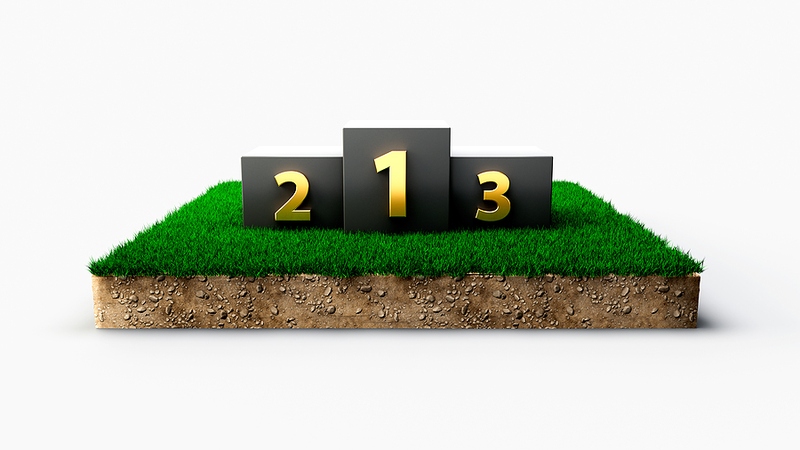
These bet types and their variations are easy enough to understand, but there are a few versions of each which we will quickly cover below.
The type of bet you ultimately choose will depends totally on the race in question, the runners that are competing, and your own knowledge and feelings around the horses.
A straight forecast might feel like the most sensible option in one race where you think there are only two horses that stand a chance of finishing first and second, but one is considerably more fancied than the other; but a race that is tougher to call with a handful of real contenders might work better as a reverse tricast.
It just depends.
Forecast: 1st and 2nd
Straight forecasts involve backing the first two finishers in a given event in the correct order and can be used to increase the odds when you are confident of a particular horse (for instance) winning, but whose odds are restrictively short. Adding a longer odds runner in the second position of a straight forecast will increase the odds significantly.
So if you back the favourite and another at longer odds in a straight forecast to finish in that order your total return would obviously be significantly better than if you just backed the winner. Obviously the odds (and returns) are higher because the chances of success are lessened, but it’s up to you to assess when the value exists sufficiently to place a straight forecast.
Tricast: 1st, 2nd & 3rd
A straight tricast is almost the same as the straight forecast except you must pick the first three in the correct order, and – given the chances are diminished still further – the returns from a successful tricast can be very tasty indeed.
Reverse Forecast: 1st & 2nd in any order
If you are confident of which two horses (or whatever) will finish in the top two, but not which of the two will win, you might instead opt to place a reverse forecast, which is akin to an each way bet and is two bets which covers whether horse A is first and horse B is second, or vice versa. Your stake will be twice what it would be for a straight forecast.
Combination Tricast: 1st, 2nd & 3rd in any order
In the same way, you can place a combination tricast which covers all six possible combinations of three selections finishing in the top three positions in any order. This will thus be six bets and cost you six times as much as a straight tricast for the same unit stake.
You can go even further, though, and place a combination tricast from more than three selections in which you are backing the top three from more than three selections. This will give you a greater chance of success as you have an extra bite of the cherry, but will cost you as the number of combinations (and hence bets you have to place) increases. For instance a combination tricast from four selection would require 24 bets, with 60 bets from five selections and a massive 120 bets from six selections.
Combination forecasts work in the same way when picking the top two from more than two selections for which the number of bets you need to cover three selections is six, with 12 bets for four selections, 20 for five and 30 for six.
Calculating Your Stake
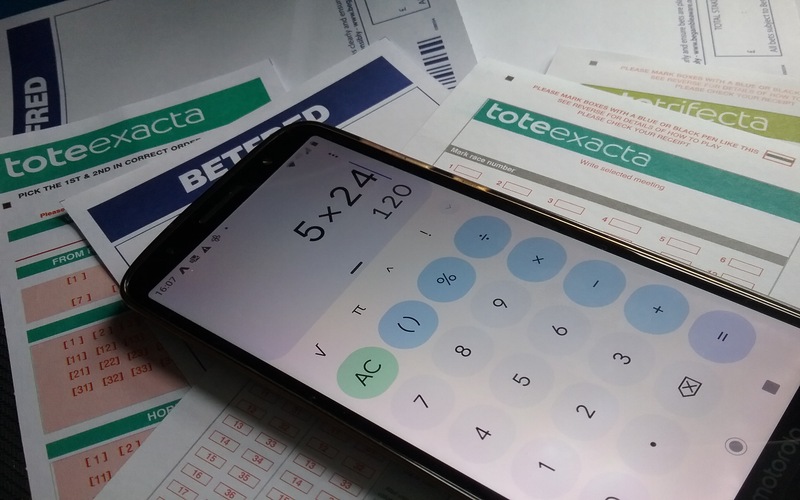
Understanding how much a given bet will cost you is not necessarily straightforward when it comes to the various bets of this nature you can place. A £5 combination tricast with four selections will, for example, set you back substantially more than £5. In fact, with 24 bets to cover, it would mean a total stake of £120! The table below covers a number of the main forecast and tricast options, detailing how many bets they involve and thus what you must multiply your base stake by to get the total cost of the bet.
| Bet | Information | Stakes Required |
|---|---|---|
| Forecast | First two in the correct order | 1 |
| Reverse Forecast | First two in either order | 2 |
| Combination Forecast (three picks) | First two in any order from three selections | 6 |
| Combination Forecast (four picks) | First two in any order from four selections | 12 |
| Combination Forecast (five picks) | First two in any order from five selections | 20 |
| Combination Forecast (six picks) | First two in any order from six selections | 30 |
| Straight Tricast | First three in the correct order | 1 |
| Combination Tricast | First three in any order | 6 |
| Combination Tricast (four picks) | First three in any order from four selections | 12 |
| Combination Tricast (five picks) | First three in any order from five selections | 60 |
| Combination Tricast (six picks) | First three in any order from six selections | 120 |
| Combination Tricast (seven picks) | First three in any order from seven selections | 210 |
Few punters would ever perm as many as seven picks for a combination tricast, or six for a forecast. However, in theory you can choose even more, depending on how many runners are in the race. The more picks you add though, the more the total wager will set you back and as you get past three or four different horses the jump in the number of total stakes gets very big.
How To Place a Forecast or Tricast Online
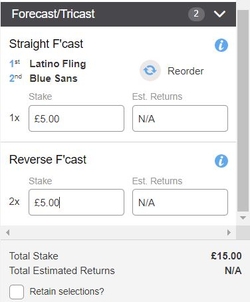 Exactly how you go about placing this type of bet online will vary according to which site you are betting with.
Exactly how you go about placing this type of bet online will vary according to which site you are betting with.
There will be slight variations and it may not always be simple as there are various ways to place what often amounts to the same bet.
When it comes to straight forecasts and straight tricasts, some online bookmakers will offer fixed odds options.
These may be listed as forecasts and tricasts, first two and first three or something similar.
With this type of wager, you will usually see various permutations of the horses at the top of the market.
So for example you might see the following hypothetical options:
- Big John and Little Mick – 4/1
- Little Mick and Big John – 6/1
- Big John and Dingohead – 7/1
- Dingohead and Big John – 10/1
- Little Mick and Dingohead – 9/1
- Dingohead and Little Mick – 14/1
How many different options you see will depend on the bookie, the number of runners in the race and how prestigious the contest is. Let’s say you fancied a bit of an upset and wanted to place a “forecast” of Dingohead to win and Little Mick to come second. You would simply select the sixth option listed above and have this as a fixed odds 1-2 at a price of 14/1.
This sort of bet works in exactly the same way for the first three but obviously there you would see three horses (or dogs) listed in order. Many would argue that these are not true forecast or tricast bets but they certainly make things very simple and have the added advantage that you know what you stand to win. Such bets will only ever involve a single stake, the odds adjusted to take into account whatever selections you make. On the downside, the bookie will not be able to list all possible combinations and, especially if you fancy a real outsider, there is a high chance the duo or trio you fancy will not be available.
In addition, generally speaking, these sorts of fixed odds bets offer lower payouts than the more traditional style of forecast or tricast. Some bookies may offer similar fixed odds reverse or combination options. These again work in the same way but the market will specify that the runners can finish in any order. With a combination bet of this nature you might see it presented as “Two of Big John, Dingohead and Little Mick to finish first and second in any order” for example.
“Proper” Forecasts and Tricasts
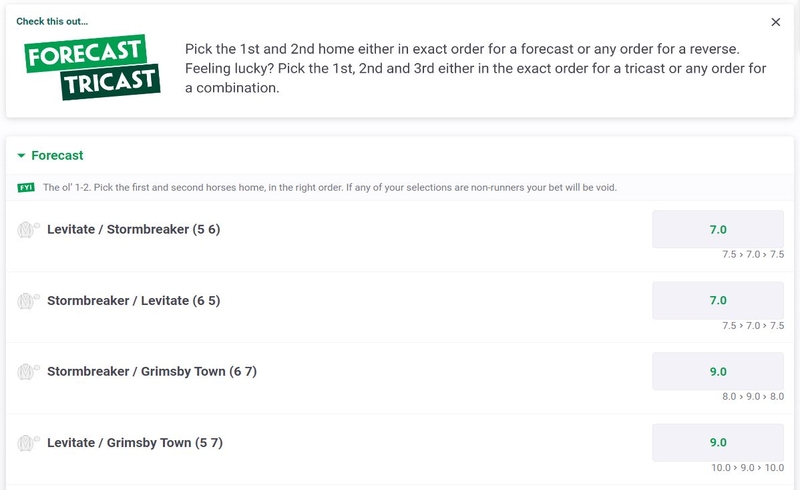
To place a bet in the sense that these terms are more traditionally understood, with winnings dependent not on the bookmaker’s odds but the Computer Straight Forecast (CSF) dividend (of which more shortly), once again, bookies may present things differently to one another.
Some sites have specific markets for these bets where you click the horses you want to come first, second and, where applicable third. They may also have a separate dropdown or box to indicate that the selected runners are to be part of a combination or reverse bet and thus can finish in any order.
Other sites simply have the main market for the outright winner of the race and you create your forecast from here. For example, once you add two horses to your betting slip, you will be offered the choice of either backing them as a reverse forecast (involving two bets), a straight forecast in the order presented (one bet), or swapping the order of the horses to place the straight forecast but with the horses in the opposite first/second order.
Should you add a third horse from such a market to the betting slip you will have the option to place a straight tricast (and again be given the chance to order the three as you see fit), a combination tricast or a combination forecast. This process will be repeated should you opt for more selections, though once you add four or more the facility to place a straight tricast will disappear from the slip and the total number of bets/stakes required will increase accordingly.
However you go about placing these predictive wagers, you should be told how many bets will be involved. Thus, if you add four horses to your slip, the box to select a combination tricast will show that you are placing 24 bets, with the combination forecast showing 12 bets. Whatever stake you add to whichever box will be multiplied accordingly and the total stake indicated. From here you simply confirm the bet as you would with any other.
How to Write Out a Forecast/Tricast Betting Slip
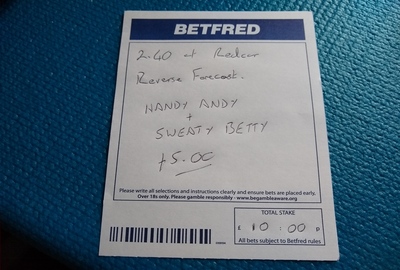 Should you prefer to place a bet like this in a betting shop, you should be able to ask a member of staff for any help if you are unsure what to do. Generally speaking there are no hard and fast rules about how one must manually write out a slip in a bricks-and-mortar shop. As long as you make your intentions clear you should be fine. So, for example, you might write the slip broadly as such:
Should you prefer to place a bet like this in a betting shop, you should be able to ask a member of staff for any help if you are unsure what to do. Generally speaking there are no hard and fast rules about how one must manually write out a slip in a bricks-and-mortar shop. As long as you make your intentions clear you should be fine. So, for example, you might write the slip broadly as such:
2.40 Redcar Reverse Forecast – Handy Andy and Sweaty Betty, £5, total bet £10
As long as you make the race, bet type, selections, unit stake and total stake all clear, the exact format and order don’t really matter. Some shops may have specific slips or forms for such a bet but otherwise a plain slip will do and, as said, if you are not confident in what you are doing, just ask.
How Are Payouts Calculated?

There are three main ways to place this type of bet, two of which we have mentioned, and one of which we will discuss shortly. With the fixed odds option… the odds are fixed. This means that payouts are calculated in the same way, by multiplying your stake by the applicable odds.
When it comes to what many would consider to be a “normal” tricast or forecast, things are somewhat more complex. First of all, it is important to note that you will not see any odds when you place the bet, nor know what you stand to win. Shortly after the race, a Computer Straight Forecast (CSF) dividend will be announced and this equates to the return from a £1 bet on the correct 1-2 combination for that race. Where applicable a Tricast dividend will also be declared, working in exactly the same way but for those who were bold and tried to predict the first three horses home.
The CSF and Tricast dividends are calculated using a complex and relatively secretive formula. There are some who claim to have obtained a copy of the exact formula, whilst others dispute this and suggest it has been changed a number of times over the years. Who exactly sets, controls, alters or created the formula is also unclear but what we can be fairly sure about is that its exact workings are highly complex.
That said, nobody disputes that the following are among the factors that impact the size of the dividend:
- The number and odds of the horses in the race
- The odds of the horse that won and the horse that came second (and third where appropriate)
- The price of the favourite and how it did in the race
- Draw bias at the track and the draw of the runners
- Race type
- The number of horses at long odds (defined by some as 20/1 and above)
Almost as soon as the official result is declared, so too will the relevant dividends be. These are used by a number of major bookies so generally speaking the “odds” for this type of bet do not vary from one site to another. Equally bets placed in high street betting shops or even at the track itself will often use the CSF.
Do Tote Bets Offer Better Value?
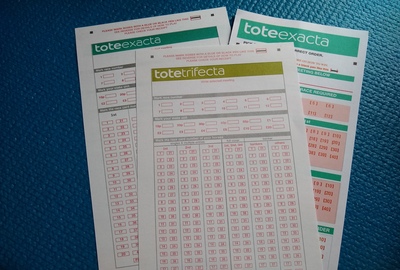 The third way to place such a bet is using the Tote system, either direct with the Tote at a racing track or online, or via an affiliated partner. As with all Tote wagers, these are parimutuel pools bets. This means that the payout is not pre-determined by the bookie, nor is it set using a computer algorithm but, instead, it depends on how much was wagered in total and what proportion of those bets were winners.
The third way to place such a bet is using the Tote system, either direct with the Tote at a racing track or online, or via an affiliated partner. As with all Tote wagers, these are parimutuel pools bets. This means that the payout is not pre-determined by the bookie, nor is it set using a computer algorithm but, instead, it depends on how much was wagered in total and what proportion of those bets were winners.
Placing your tricasts and forecasts this way is similar to using the CSF in that winnings are only declared after the race and in dividend form. They will vary depending on how many people managed to predict the correct two or three horses home but very broadly speaking the payouts will tend to reflect the odds.
Tote offers a range of bets that cover all of the main forecast and tricast options you migh want to place. These are:
- Exacta – same as a straight forecast
- Combination Exacta – like a reverse forecast
- Banker Exacta – an additional Tote bet where you name a single horse to finish first with two or more to finish second
- Trifecta – akin to a straight tricast
- Combination Trifecta – Tote equivalent of a combination tricast
However, a very common question among racing fans, particularly those that like this type of bet, is: which offers better value, the various Tote options or the ones that use the CSF? There is no single answer to this and it will vary. Sometimes one may offer a much bigger payout whereas at other times the other might have been the better option.
Tote payouts are subject to greater variance because they are highly dependent on how many people pick the winner. If a very unlikely trio of horses fill the first three spots home you might expect a very large win. However, just by random chance it could be that several other people happened to “fluke” the same three dark horses and this would see your share of the pool cut dramatically.
That said, a lot of research has been put into comparing the various payouts offered by the two main systems (fixed odds options are generally disregarded as they do not allow for all permutations and in general the payouts are poor). We have undertaken this ourselves for various sister sites of ours, whilst many other interested parties have done similar comparisons.
The general consensus is that, whilst payouts will and can vary and there are no rules that are set in stone, in general Tote will yield better results. Some very canny and shrewd punters believe there are certain very specific circumstances where the CSF can often offer good value but these are very hard to identify. However, most punters believe that much of the time the CSF delivers very poor returns.
For the casual punter, there is unlikely to be too much in it and sometimes you might have won more with one method of betting whilst at other times you would have been better with the other. Obviously landing a racing 1-2, or even 1-2-3 is far from easy, so you are not going to have too many winners to compare in any case unless this is a wager you make an awful lot. However, if such a thing as a simple answer can be given to this question it is that Tote is (probably) better. Most of the time.
